Ghosts: Comparing the Characters, History & Humour in the UK and US Comedies
With season 2 airing now on CBS, here's what the US Ghosts shares with the UK original, and where they differ.
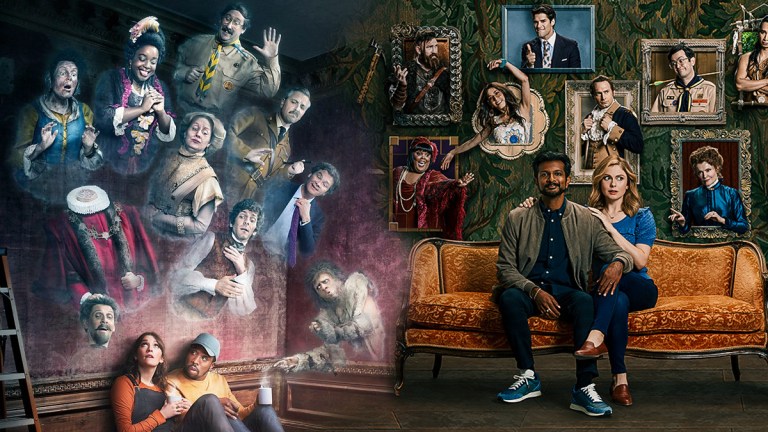
Warning: contains spoilers for both shows
Ghosts (UK) has just finished its fourth series on BBC One, and Ghosts (US), the American adaptation, is a few episodes in to its second season on CBS. Both series offer a mix of dry humour, black comedy, and real warmth in their characters. Both shows can make you laugh and cry within the space of a few minutes as they swing from comedy to tragedy and back again. But there are a fair few differences between the two that remind us of some of our differences in both the history of the two countries, and the humour.
The original British show is written by and stars the sketch comedy team behind the children’s television classic Horrible Histories. The team’s passion for history is clear throughout the show and the selection of ghosts from various historical periods who could possibly have died on the grounds of a British country house reflects their skills in historical comedy. The American adaptation takes the same idea, but of course it has to be adapted to American history.
Straight Character Swaps: Pat/Pete & Julian/Trevor

Only one of the eight regular ghosts from the British original is directly transplanted into the US version – Scout leader (or in the first UK series Adventure Club leader) Pat Butcher/Pete Martino (Jim Howick/Richie Moriarty), whose characterisation and backstory is almost identical in both shows.
The next closest connection between a UK ghost and their US counterpart is Julian/Trevor (Simon Farnaby/Asher Grodman). Both died wearing a shirt, tie and blazer but no trousers and both are the most recently deceased ghost in the house; Julian is from the early 1990s and Trevor from the year 2000. However, Julian is an MP who died in a scandalous sex act, whereas Trevor is a young finance executive. Executive producer Joe Port told Den of Geek that “the 90s British sex scandals in Parliament were such a specific thing… Obviously, we had our own 90s sex scandals”, referring of course to President Clinton’s impeachment following lying about his affair with Monica Lewinksy. However, the impeachment of a President made that a rather more serious incident for the US. “The douchey finance bro to us seemed like a fun American archetype to explore,” Port said. “I went to college with so many of those guys at Penn.”
Hetty Woodstone (Rebecca Wisocky, US) is also very similar to Lady Button (Martha Howe-Douglas, UK), though she’s from a slightly earlier time period, and considerably less moral. Lady Button is an uptight but upstanding Edwardian lady, whereas Hetty is a late 19th-century robber baron. Although she shares some of Lady Button’s old-fashioned views on modesty, women’s roles in society, class, and so on, Hetty is also an unapologetic borderline criminal, which Lady Button most certainly is not.
Sexuality and Race: The Captain/Isaac & Kitty/Alberta
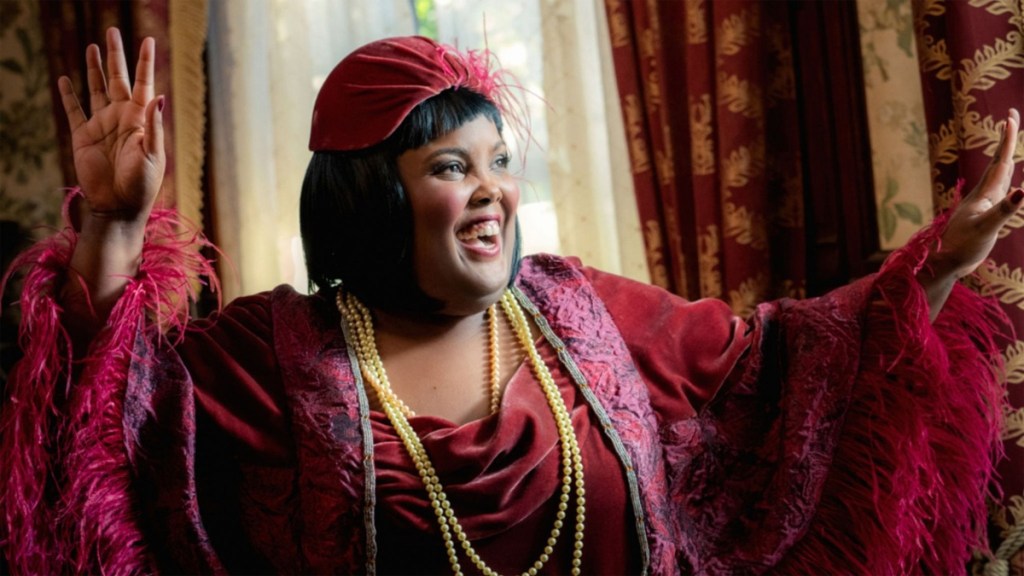
There are fairly obvious reasons for the different period choices when it comes to the Captain/Isaac (Ben Willbond/Brandon Scott Jones). The choices of a British World War Two officer and an American War of Independence officer show the significance of the two wars in the two countries. World War Two was, of course, very important in American history as well, but for Americans it was a war fought primarily overseas, whereas for British people, it was fought in their own homes and cities, as we see in the taped-up windows of Button House during flashbacks to the Captain’s time there. The American War of Independence, on the other hand, is a war that, for obvious reasons, is very important to Americans but not much talked about in Britain.
Both shows aim to deal sensitively with the history of racism when it comes to characters of colour in the cast. The only regular ghostly character of colour in the UK series (there are more living people of colour) is a Black woman, Lolly Adefope’s Kitty, who is presumably inspired by the real life British woman Dido Elizabeth Belle. Dido Belle was born in 1761; her mother Maria Belle was an African enslaved woman in the Caribbean, and her father was British naval officer Sir John Lindsay. Lindsay took Dido Belle to England when she was very young, and she was raised by his uncle, the Earl of Mansfield, alongside her cousin Elizabeth Murray. Kitty being raised by her white father alongside a white sister seems to echo Dido Belle’s story pretty closely, and her unequal treatment also reflects real life.
Kitty’s story wouldn’t work in an American context, and considering the show is a light-hearted comedy, including an enslaved character would result in some probably very awkward shifts in tone. US Black character Alberta (Danielle Pinnock), therefore, comes from the 1920s. She makes regular references to racism and to the struggles she faced as a Black woman, but she was not enslaved, and she can also be the focus of stories about brighter topics like enthusiastic fans thanks to her status as a minor celebrity. As Port told Den of Geek, “Race is so much a part of the story of America, and it’s something that we want to handle delicately and respectfully and honestly.”
Historical Divergence: Sasappis, Robin, Thorfinn & Thomas

It was also important for the US version to feature a Native American character, something obviously not relevant to the British version (the indigenous people of Britain are Celts). “Having a Native character was always our number one priority amongst the cast,” Port says. “We have Native representation in the writer’s room, we have in the cast obviously, and we have a Lenape consultant. It’s something that we really take care to get right.”
Lenape character Sasappis (Román Zaragoza) is roughly the same age as the British recurring ghost Sir Humphrey (Laurence Rickard and Yani Xander). He could have been from any historical period really, but the choice of the 1500s pre-dates much of the tragic history between Native Americans and European colonizers, while keeping him recent enough for historians to have a decent idea of his history and culture. It also provides an opportunity for the show to feature some older ghosts, beyond the not-quite-300-year history of the United States.
One British character with no American equivalent – though Sasappis fills the gap in the cast – is Thomas the Romantic poet (Matthew Baynton, who is incidentally set to cameo as a new character in the US show’s second season). This probably says something about the British obsession with romantic literature of the early 19th century, inspired by Shelley and Byron, but also by the contemporary romance novels of Jane Austen. Thomas’ defining characteristic is his lovelorn nature and hopeless yearning for Alison (Charlotte Ritchie).
Writer/actor Laurence Rickard stated on the BBC Sounds podcast Inside… Ghosts that the team made a deliberate decision to feature as wide a range of ghosts as possible, including both “really really old ghosts” as well as “almost contemporary ghosts”, and this is why the UK show has the unusual inclusion of his character, Robin the caveman. The US version similarly showcases characters from across a wide range of history, but the US showrunners made a different choice with their oldest ghost. A caveman could appear as a ghost in America just as he can in Britain, but the US series has replaced Robin the caveman with Thorfinn the Viking (Devan Chandler Long).
Presumably this reflects an interest in earlier migrations to America, before the journeys of Christopher Columbus or the Mayflower, though the switch has given Thorfinn rather inexplicably odd speech patterns. The reason Robin struggles with speech is because he has a small speech centre, and his culture had very limited speech – he never spoke a complete human language when he was alive. The Plague Ghosts in the British version and Sasappis in the US version, on the other hand, all spoke a complete, developed language when alive and have learned modern English as ghosts. It makes no sense that Thorfinn speaks in incomplete English, like Robin. He would have spoken a complete human language when alive and should be just as capable as Sasappis of learning English after death. Maybe the lightning strike scrambled his brains.
Cultural Folklore
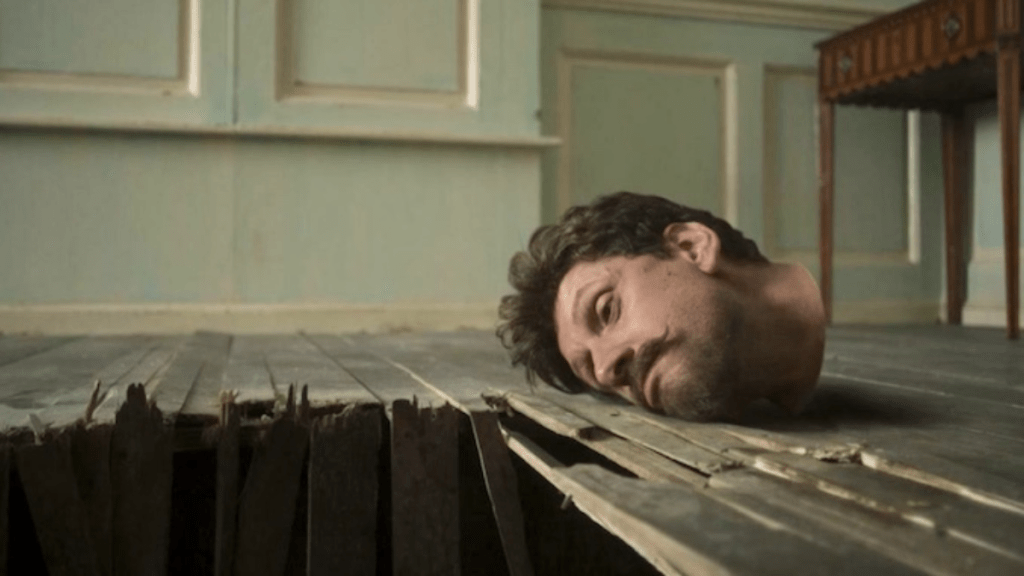
Some characters in the British show also reflect British ghost story themes. The headless ghost is a familiar trope in British ghost folklore, usually associated with executed nobles in the Tudor period, though Ghosts’ Sir Humphrey turns out to have lost his head in an accident. The American writers were clearly attracted to the idea of the physical humour resulting from a body walking around without a head, but lacked the historical tradition to go with it. We presume that Crash (Hudson Thames) is the victim of a car accident, given his James Dean-inspired costume, but we’ve barely seen him – it seems the US series is not quite sure what to do with him.
The main bit of US folklore to have made its way into the show so far is attic ghost Stephanie’s (Odessa A’zion) backstory. The American show has introduced a lot more ghosts beyond the main eight (nine including Sir Humphrey/Crash), primarily as a result of needing to fill more episodes (the British show only has 22 episodes to date, whereas season 1 of the US version alone has 18 episodes). We’ve had ghosts sealed into ghost-proof vaults, ghosts revealed to be living in a shed on the edge of the property, ghosts called up in a séance, ghosts who haunt Samantha’s workplace, and Stephanie, a teenaged ghost who spends nearly all her time sleeping in the attic. Stephanie was murdered by a chainsaw killer on the night of her prom, which is pure American urban legend.
The US series has wisely avoided the old American horror tropes of haunted Native American burial grounds or psychiatric hospitals. Interestingly, they have also avoided a few tropes common to both countries that are featured in the British version. Grey Lady ghosts like Lady Button are especially common in Britain, but the idea of a ghostly “woman in white” is known in America as well, and unlike Alison, Samantha (Rose McIver) has yet to bump into a murdered hitchhiker even though there are hundreds of those in US urban folklore.
The US writers also avoided setting the show in Salem and including a ghost who was executed for witchcraft, even though the British original features just such a ghost, Mary (Katy Wix) (who has inaccurately been burned rather than the English execution method of ducking and/or hanging witches). Mary’s role in the show is filled by Flower (Sheila Carrasco), a 1960s hippie who was high when she died and can make the living high if she walks through them, a considerably more pleasant experience than Mary’s ability to make them smell burning. Flower is a surprising choice in terms of ghost story folklore, but her presence indicates the importance of the history of hippies and the movements for free love, anti-war protests, and feminism in the cultural history of America in the 20th century.
British Horror
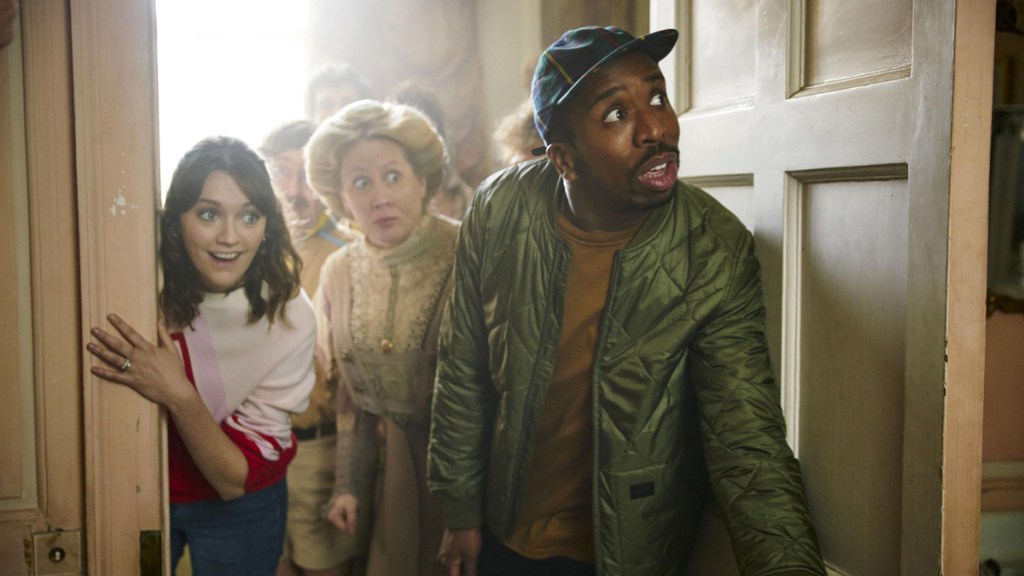
These changes to the more ‘ghost story’ aspects of the show also reflect a slight difference in tone between the two versions. The British version, although primarily a light-hearted sitcom, occasionally leans in to the horror side of ghost stories, whereas the American version, despite the discovery of Alberta’s murder and the addition of a ghost being seen actually going to Hell, leans more into the ‘bright sitcom’ side of the story.
The US pilot had to be 10 minutes shorter, and the storyline it cut was Lady Button re-enacting her own murder every day, which we see happening over and over again in the British version, played for laughs. The UK show also plays up the creepiness factor, and little girl Jemima (Anya McKenna-Bruce) and the Plague Ghosts who live in the boiler room are positively chilling in their initial appearances. The US version of the Plague Ghosts is the Cholera Ghosts, who are equally unpleasant to look at but play a more broadly comic role, especially Pete’s fake girlfriend Nancy (Betsy Sodaro).
The ghosts trying to drive Alison out in the second episode of the UK show is also properly scary and Thomas is the creepiest, who doesn’t want to get rid of her, but wants her to kill herself to be with him. And of course, in the British version Julian outright tries to murder Alison in the first episode, whereas in the American version Samantha trips and falls by accident after Trevor’s attempt to push a vase over was more successful than Julian’s. There is a slightly darker tone to the “haunting” aspects of the UK series.
US Humour
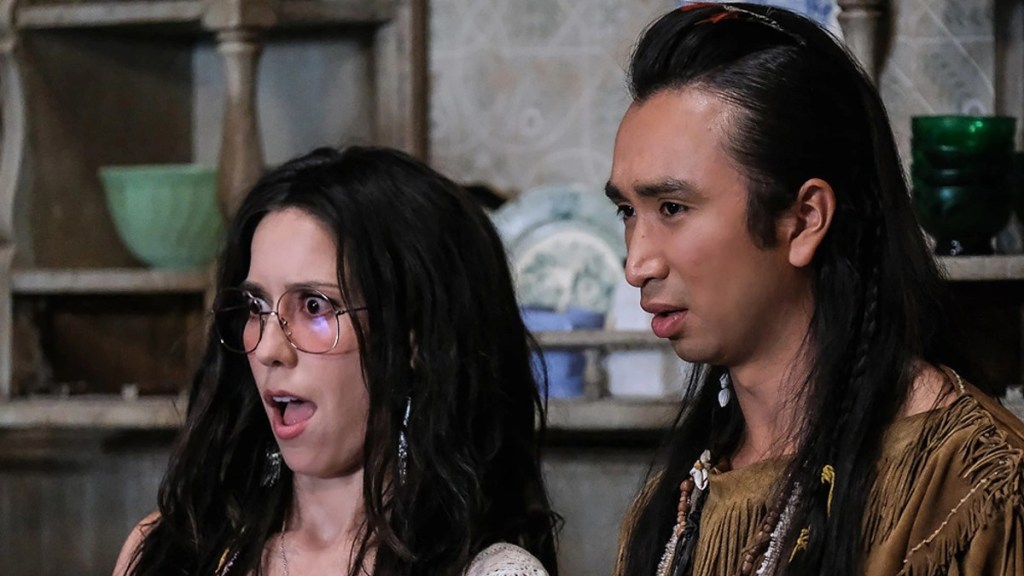
The US series, on the other hand, leans more into a broader form of comedy, especially in the earlier episodes. For example, although Alison tells us that Julian isn’t wearing “pants” (i.e. underpants), Trevor is directly shown to be wearing no underwear, as occasionally the camera has to blur out his private parts – although it turns out that the reason Trevor has no underwear is rather sweeter and more innocent than Julian’s scandalous sex act.
Pat/Pete’s death is also treated slightly differently even though their backstory is the same. Although Trevor, unlike Julian, didn’t try to murder Samantha/Alison, Pete was directly killed by a young girl accidentally shooting him, whereas Pat tried to drive away from the scene and was technically killed when he drove his car into a tree. The British series has also done an episode dealing with the traumatic effect of this incident on the young boy who accidentally shot Pat, whereas so far as American series has left the poor little girl as a brief joke.
We can see the broader humour in the American version most clearly in the characterisation of the Captain and Isaac. Both are closeted gay men in deep denial about their own sexuality. However, the Captain is quiet and repressed, his sexuality indicated by occasional comments like observing that Alison’s husband Mike (Kiell Smith-Bynoe) would “make a very fine soldier”. Isaac, especially early on, plays much more into gay stereotypes, with a fairly camp line delivery, and loudly declaring his love for musical theatre.
Both men have romantic storylines that are treated seriously and sensitively, but where the Captain has only the memory of a man he liked but who went away to war to keep him going, Isaac accidentally shot the man he had a crush on to death while spying on him, resulting in both of them haunting Woodstone Manor and ending up in a relationship after death. It’s a sweet storyline, but it’s much broader humour – as well as a happier ending – than the British version.
Both series can be very moving and both feature sequences that are genuinely emotionally touching, whether that’s Robin naming the stars in the UK version or Sasappis speaking along with living Lenape representative Bob in the US version. Both show us an uptight society lady learning to broaden her horizons, a repressed gay army officer coming to terms with his sexuality, and a young couple trying to start a new business and navigating whatever comes their way. And both are an absolute joy to watch and highly recommended, whatever the differences between their British and American sensibilities.
Ghosts Series 4 is available to watch in the UK on BBC iPlayer. Ghosts (US) Season 2 is currently airing on CBS.
